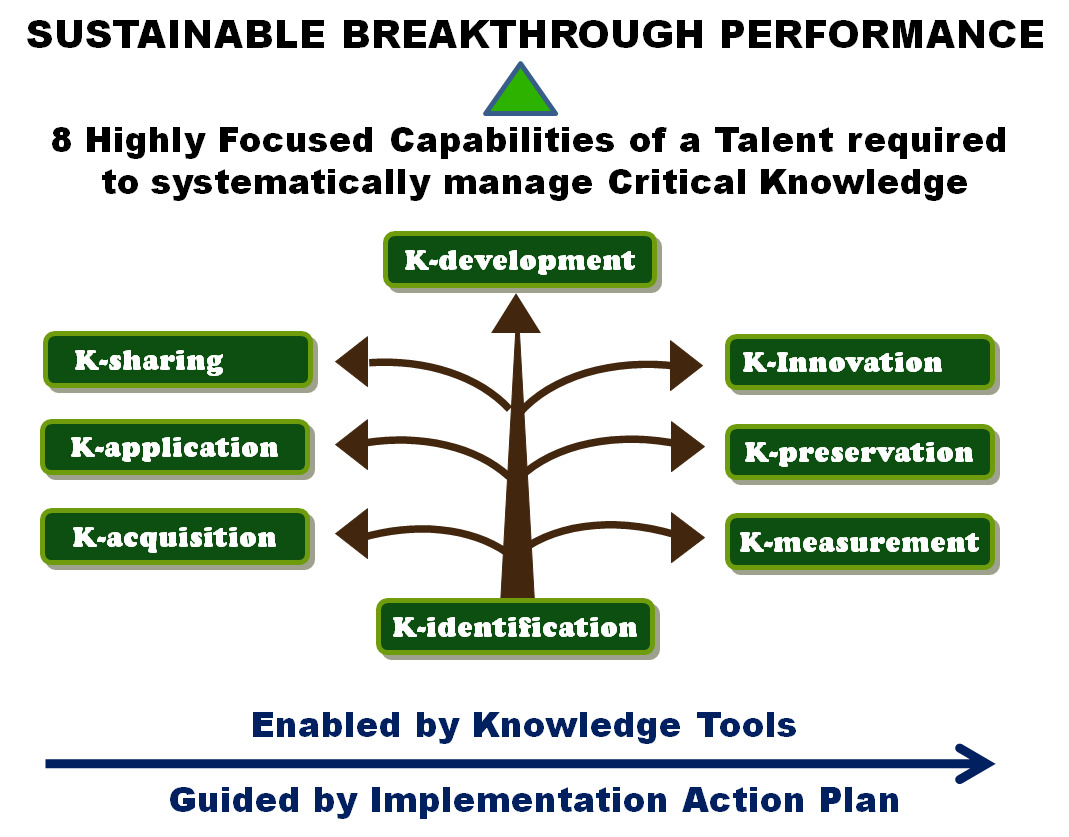Introduction
The FrankieKnowledge Practice of Knowledge Management (POKM) Model was conceptualised by FRANKIE in 1996. Over the last 20 years, more than 1000 organisations from 23 countries have benefited from this Model.
The FrankieKnowledge POKM Model
Working Definition
WHAT is BREAKTHROUGH PERFORMANCE ?
Breakthrough Performance refers to Highly Significant Performance that is achieved through Focused, Concentrated, Consistent and Synergistic Efforts.
This suggests that Breakthrough Performance is about getting Beyond the Standard, Normal or Usual Performance level. It is really about ensuring that the Desired Outcomes are More Outstanding and Obviously More Superior than past achievements, patterns and trends
For instance, Breakthrough Performance can be measured and demonstrated by the AMOUNT of SIGNIFICANT and QUANTITATIVE IMPROVEMENTS in 1| Revenue Value, 2| Sales Volume, 3| Customer Acquisition, 4| Service levels, 5| Service Responsiveness, 6| Service Consistency, 7| Product Innovation, 8| Promotion Campaigns, 9| Project Leadership and Management, 10| Cost Management and Reduction, 11| Technical Excellence, 12| Quality Management, 13| Health and Safety, 14| Process Reengineering, 15|Logistics and Distribution Time, 16| Talent Retention and Development, 17| Deadline Achievements and 18| related Breakthrough Performance Indicators
To really achieve Breakthrough Performance, especially in challenging times, the talents must be equipped with Highly Crucial Capabilities required to systematically manage the desired Critical Knowledge
To be very specific, there is a Direct Correlation between the capabilities to manage Critical Knowledge and achieving Breakthrough Performance
KEY ILLUSTRATIONS of
MEASURABLE BREAKTHROUGH PERFORMANCE OUTCOMES
To be very specific, Breakthrough Performance must be MEASURABLE and the amount of Significant Improvements (over a specific period of time) must be QUANTIFIABLE (for example, in statistical units, in percentage or related Breakthrough Perf. Measurement Indicators) Some Key Illustrations of Measurable Breakthrough Perf. Outcomes are listed below-
| Desired Breakthrough Performance Areas in 2016 |
Key Measurable Breakthrough Performance Outcomes in 2016 |
| REVENUE VALUE |
|
|
SALES |
|
| CUSTOMER ACQUISITION |
|
| SERVICE LEVELS
SERVICE |
|
| PROJECT LEADERSHIP and MANAGEMENT |
|
| COST MANAGEMENT and COST REDUCTION |
|
| TALENT RETENTION and DEVELOPMENT |
|
WHAT is PRACTICE Of KNOWLEDGE MANAGEMENT?
LEVEL ONE
The Practice of Knowledge Management (POKM) is about developing 8 Highly Focused Capabilities of a Talent to systematically manage Critical Knowledge leading to the achievement of Sustainable Breakthrough Performance.
In the context of this working definition, the word, – “Capabilities” refers to –
1| equipping the talent with “Key Abilities and Skills” required to systematically manage Critical Knowledge [immediate focus] and
2| the talent’s “Capacity and Potential” for further enhancement [near future focus]
The 8 Highly Focused Capabilities required to systematically manage critical knowledge are, – 1| Knowledge Identification, 2| Knowledge Acquisition, 3| Knowledge Application, 4| Knowledge Sharing, 5| Knowledge Development, 6| Knowledge Innovation, 7| Knowledge Preservation and 8| Knowledge Measurement.
The consistent application and internalisation of these 8 Highly Focused Capabilities will progressively transform the individual and the team to be More Self-driven, Pro-active, Collaborative and Innovative to secure and maintain Sustainable Breakthrough Performance by managing Critical Knowledge in this highly challenging Knowledge-based and Innovation-driven Economy
LEVEL TWO
To INTENSIFY the Practice, CRITICAL FUNCITONS and PROJECT TEAMS must be selected to PIONEER the Practice of Knowledge Management, enabled by KNOWLEDGE TOOLS and guided by IMPLEMENTATION ACTION PLANS.
At this level, the Key Focus is to facilitate the selected Critical Functions and Project Teams to achieve the desired Breakthrough Performance by increasing OPERATIONAL EXCELLENCE, improving CUSTOMER RESPONSIVENESS and accelerating INNOVATION INTENSITY
LEVEL THREE
In the long run, when more Critical Functions, Project Teams and Practising Communities begin to adopt the Practice of Knowledge Management, the company will gradually be transformed into a KNOWLEDGE-based and INNOVATION-driven Organisation. For this to really happen, a structured Roadmap must be formulated and implemented to guide the Organisational Transformation Process. Some companies may even establish their POKM CENTRES to drive this process
In addition, to “tangibilise” their efforts to build a STRONG KNOWLEDGE-enabling CULTURE to SUSTAIN and INNOVATE the POKM Journey, companies may put in place Knowledge-based and Innovation-driven PHYSICAL ARCHITECTURES
Physical Architectures
Physical Architectures conceptualised and designed by Frankie and his team

















